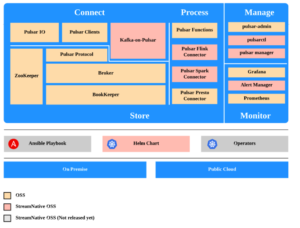

(Jurik Peter/Shutterstock)
StreamNative, which launched a cloud-based version of Apache Pulsar two months ago, today announced that it’s now offering a free entry-level version of Pulsar in the cloud.
Apache Pulsar is the open source publish-and-subscribe (pub-sub) system that competes with Apache Kafka. The software was originally developed at Yahoo to be a geographically distributed, cloud-native messaging system that delivers large volumes of messages in a durable and low latency manner.
Since Yahoo released it as open source in 2016, Pulsar been adopted by a handful of large companies, including Tencent, Verizon Media, Yahoo Japan, Comcast, Appen, Overstock, and Nutanix.
The most recent adopter perhaps is Splunk, the big machine data analytics firm, which announced last week at its .conf20 event that it has adopted Pulsar as the core technology underlying the latest release of its Splunk Data Stream Processor (DSP), beating out Kafka.
Splunk’s move perhaps was not surprising, considering that it acquired Streamlio, one of the biggest proponents of Pulsar, one year ago. In addition to netting Streamlio’s software, it brought several of the founding members of the Pulsar project into the big data company.
That acquisition created space for StreamNative, another startup founded around Pulsar, to emerge. StreamNative was founded by Siji Guo, who was one of the original developers of Pulsar and Apache Bookkeeper. Guo, who is a PMC member at the Apache Software Foundation, was also one of the founders of Streamlio, but left the company in 2018.
According to Guo, who is also the CEO of StreamNative, the new free cloud offering will remove barriers to giving Pulsar a whirl.
“When we launched StreamNative Cloud’s Hosted offering, we wanted to remove barriers to adoption for Pulsar,” Guo said. “While it was a great fit for companies that were further along in their adoption journey, there was high demand from people who were just getting started. Namely, developers who wanted to try Pulsar without having to put down a credit card or get approvals. The free offering makes this possible.”
According to the terms of StreamNative’s free cloud offering, interested parties can get a Pulsar cluster with a 1GB of data up and running free of charge, with just a few clicks. The cluster. which runs on Google Cloud, is limited to 100 topics and a throughput of 1 MBps.
It’s not a large cluster, by any means, but it’s free and it lets people get started with Pulsar quickly, which is the whole point. And if customers are happy, they can upgrade to a larger and more capable Pulsar cluster.

StreamNative is developing its Apache Pulsar stack for stream processing (Image courtesy StreamNative)
StreamNative, which has offices in Beijing and San Francisco, launched its StreamNative Cloud offering in August 2020 to provide users with a simple, fast, reliable, and cost-effective hosted Pulsar experience. While Pulsar itself streamlines infrastructure and operations compared to other technologies in the space, “operating a production-grade often requires time and effort that many teams would rather allocate to addressing core business needs,” the company says.
One of the first company’s running on StreamNative Cloud is the Chinese company Bestpay. Weisheng Xie, the chief data scientist at Bestpay, said this about StreamNative’s offering: “With StreamNative Cloud, we are now able to launch a resilient, secure, and scalable event streaming service within minutes. It’s straightforward and extremely easy to use, which greatly boosts the efficiency of our engineering team,” Xie said.
Computing categories benefit from competition, and while Kafka has enjoyed remarkable success as a core message buys, Pulsar looks ready to give it competition. As one of the only independent providers of Pulsar services, StreamNative is a company worth keeping an eye on.
Related Items:
Splunk Makes a Whirlwind of News at .conf20
On the Radar: Promethium, StreamNative, Inzata
Apache Pulsar Ready for Prime Time
June 20, 2025
- Couchbase to be Acquired by Haveli Investments for $1.5B
- Schneider Electric Targets AI Factory Demands with Prefab Pod and Rack Systems
- Hitachi Vantara Named Leader in GigaOm Report on AI-Optimized Storage
- H2O.ai Opens Nominations for 2025 AI 100 Awards, Honoring Most Influential Leaders in AI
June 19, 2025
- ThoughtSpot Named a Leader in the 2025 Gartner Magic Quadrant for Analytics and BI Platforms
- Sifflet Lands $18M to Scale Enterprise Data Observability Offering
- Pure Storage Introduces Enterprise Data Cloud for Storing Data at Scale
- Incorta Connect Delivers Frictionless ERP Data to Databricks Without ETL Complexity
- KIOXIA Targets AI Workloads with New CD9P Series NVMe SSDs
- Hammerspace Now Available on Oracle Cloud Marketplace
- Domino Launches Spring 2025 Release to Streamline AI Delivery and Governance
June 18, 2025
- WEKA Introduces Adaptive Mesh Storage System for Agentic AI Workloads
- Zilliz Launches Milvus Ambassador Program to Empower AI Infrastructure Advocates Worldwide
- CoreWeave and Weights & Biases Launch Integrated Tools for Scalable AI Development
- BigID Launches 1st Managed DPSM Offering for Global MSSPs and MSPs
- Starburst Named Leader and Fast Mover in GigaOm Radar for Data Lakes and Lakehouses
- StorONE Unveils ONEai for GPU-Optimized, AI-Integrated Data Storage
- Cohesity Adds Deeper MongoDB Integration for Enterprise-Grade Data Protection
- Fivetran Report Finds Enterprises Racing Toward AI Without the Data to Support It
- Datavault AI to Deploy AI-Driven Supercomputing for Biofuel Innovation
- Inside the Chargeback System That Made Harvard’s Storage Sustainable
- What Are Reasoning Models and Why You Should Care
- It’s Snowflake Vs. Databricks in Dueling Big Data Conferences
- Databricks Takes Top Spot in Gartner DSML Platform Report
- Snowflake Widens Analytics and AI Reach at Summit 25
- Why Snowflake Bought Crunchy Data
- Top-Down or Bottom-Up Data Model Design: Which is Best?
- Change to Apache Iceberg Could Streamline Queries, Open Data
- Fine-Tuning LLM Performance: How Knowledge Graphs Can Help Avoid Missteps
- Agentic AI Orchestration Layer Should be Independent, Dataiku CEO Says
- More Features…
- Mathematica Helps Crack Zodiac Killer’s Code
- It’s Official: Informatica Agrees to Be Bought by Salesforce for $8 Billion
- Solidigm Celebrates World’s Largest SSD with ‘122 Day’
- AI Agents To Drive Scientific Discovery Within a Year, Altman Predicts
- DuckLake Makes a Splash in the Lakehouse Stack – But Can It Break Through?
- The Top Five Data Labeling Firms According to Everest Group
- ‘The Relational Model Always Wins,’ RelationalAI CEO Says
- Who Is AI Inference Pipeline Builder Chalk?
- Toloka Expands Data Labeling Service
- Data Prep Still Dominates Data Scientists’ Time, Survey Finds
- More News In Brief…
- Astronomer Unveils New Capabilities in Astro to Streamline Enterprise Data Orchestration
- Yandex Releases World’s Largest Event Dataset for Advancing Recommender Systems
- Astronomer Introduces Astro Observe to Provide Unified Full-Stack Data Orchestration and Observability
- BigID Reports Majority of Enterprises Lack AI Risk Visibility in 2025
- Databricks Unveils Databricks One: A New Way to Bring AI to Every Corner of the Business
- MariaDB Expands Enterprise Platform with Galera Cluster Acquisition
- FICO Announces New Strategic Collaboration Agreement with AWS
- Snowflake Openflow Unlocks Full Data Interoperability, Accelerating Data Movement for AI Innovation
- Databricks Announces Data Intelligence Platform for Communications
- Cisco: Agentic AI Poised to Handle 68% of Customer Service by 2028
- More This Just In…


























